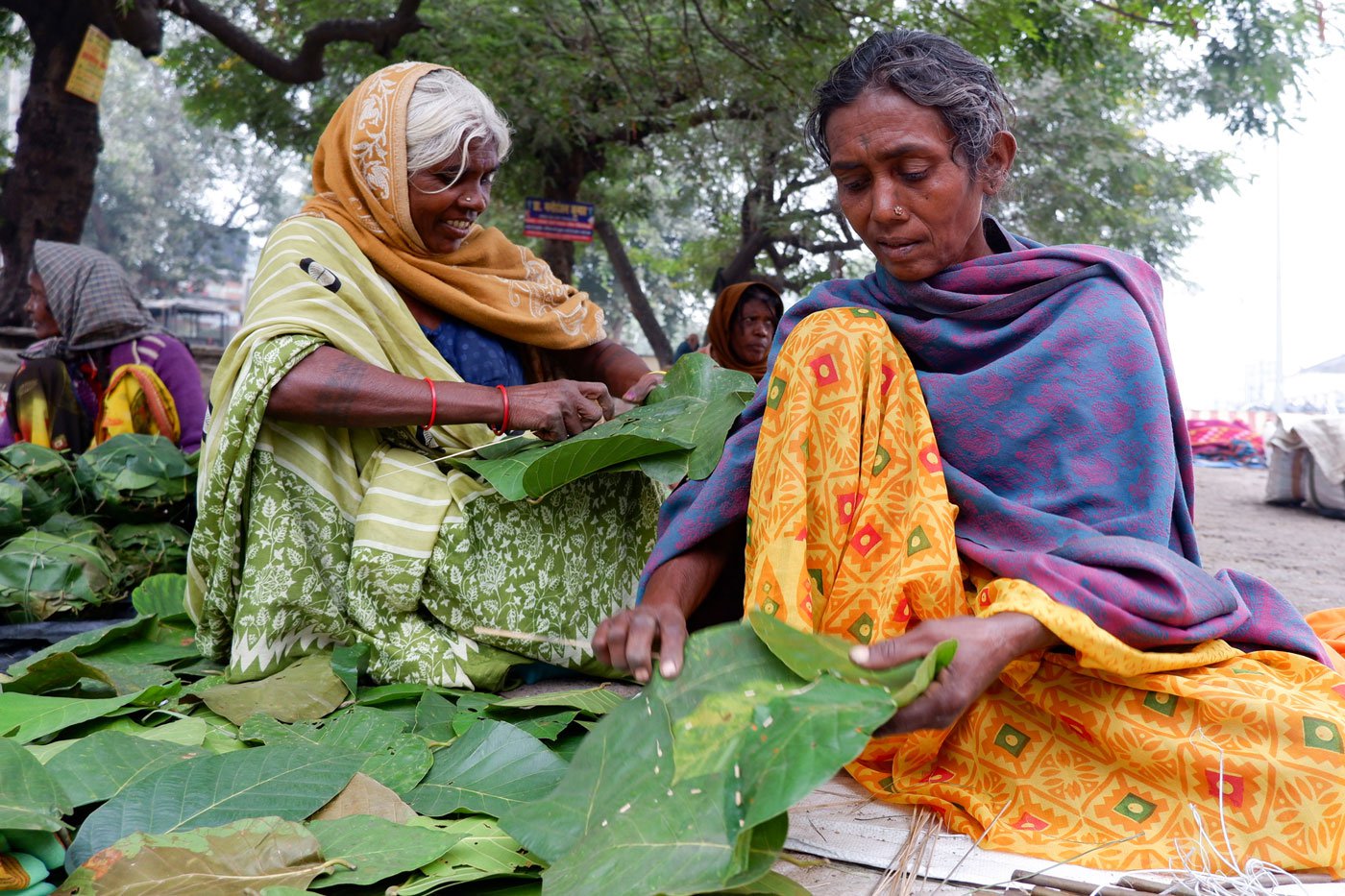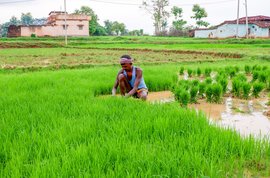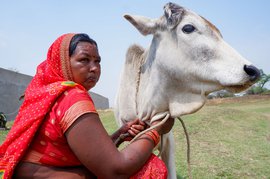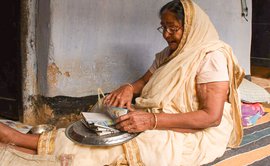“Wherever we go, we go together,” says Geeta Devi, looking fondly at her friend Sakuni, standing right next to her.
The duo collects sal ( Shorea robusta ) leaves in the nearby jungle with which they make donas (bowls) and pattals (plates) to sell in the town of Daltonganj, district headquarters of Palamau.
Geeta and Sakuni Devi have been neighbours for 30 years in Naditola, a small hamlet in Kope village. Like many villagers across the state of Jharkhand, Geeta and Sakuni are also dependent on the forest for their livelihood.
They spend seven to eight hours in the forest, heading back when they see the cattle going home after grazing. It takes them up to two days to gather enough leaves. The hours pass swiftly, they take short breaks, chat about their family and share local news.
Every morning, Geeta waits to hear her neighbour’s voice calling out, “ nikalihey… ” A few moments later they are both off, each carrying a bag made of old cement sacks with a plastic bottle of water, a small axe and a piece of old cloth. They head towards Hehegara, a jungle in the buffer zone of the Palamau Tiger Reserve in Jharkhand.
The two friends come from different communities
– Geeta is a Bhuiya Dalit and Sakuni is from the
Oraon tribal community. As we walk, Geeta also has a word of warning: “Don’t
come alone here,” she says, “sometimes wild animals also show up. We have seen
tenduas
[leopards]!” The threat of
snakes and scorpions also looms large and, Sakuni adds, “many times we have
encountered elephants.” The Palamau Tiger Reserve has 73 leopards and 267 elephants
(
2021 Wildlife Census
).


Sakuni (left) and Geeta Devi (right), residents of Kope village in Latehar district, have been friends for almost three decades. They collect sal leaves from Hehegara forest and fashion the leaves into bowls and plates which they sell in the town of Daltonganj, district headquarters of Palamau
On this foggy winter morning, Geeta and Sakuni, both in their fifties, are wearing only a light shawl. They first cross the Auranga river close to their home in the Manika block of Latehar district. The river is easier to cross on foot during winter when the water runs low, but in the monsoons the women often have to navigate neck-deep water to reach the shore.
Once on the other side, it is another 40 minutes of walking – the silence of the forest only broken by the rhythmic taq-taq-taq noise made by their flip-flops on the forest floor. They are heading towards a large mahua tree ( Madhuca longifolia ) which is the landmark for an area densely populated by sal trees.
“The jungle is not what it used to be. It was much denser before…we did not have to come this far,” Sakuni says. Global Forest Watch data shows that Jharkhand lost 5.62 kilo hectare of tree cover between 2001 and 2022.
Recalling her trips into the forest a few decades ago Sakuni says, “at any given time, 30-40 people would be in the jungle. Now it’s mostly cattle and goat herders, and people collecting firewood.”
Geeta says even four years ago there were many women involved in the craft, but the poor income from this has deterred them from continuing. The friends are among the last women in their village still engaged in this craft.
Women have also dropped out as collection of
firewood for sale is now
prohibited
. “It stopped in 2020 during the lockdown,”
Sakuni says. The Jharkhand government initially imposed a fee on the collection
of firewood and although later retracted, villagers say they still have to pay
a fee if they want to sell the dry wood.


In the area known as Naditola, Geeta lives with her large family of seven and Sakuni with her youngest son (right) Akendar Oraon
The friends' walk in the jungle is to support themselves and their families. Sakuni started this work in her twenties. “I got married when I was very young,” she says. And when her alcoholic husband left her, Sakuni had to find a way to support herself and her three sons. “There was very little work [available],” she says, “by selling leaves and datwan , I took care of my children.”
Sakuni now lives in a two-room kutcha house with her youngest son, 17-year-old Akendar Oraon. Her two elder sons are married and live in separate houses in the same village, Kope.
A few doors down, Geeta lives in a mud house with her large family of seven – a daughter, three sons, a daughter-in-law and two grandchildren. Her husband passed away five years ago. Geeta’s youngest daughter, 28-year-old Urmila Devi, also sells dona , but she wants a different future for the girl. “I had married off my elder daughter to a poor family. I won’t do that with my younger daughter. I will pay a dowry if I have to,” Geeta says.
Working from a young age, Geeta, the youngest of
seven siblings, never went to school. “If I went to school, who would do the
household work?” she asks. Even now, her day begins early, around 4 a.m. when she gets
busy with household chores such as cooking and cleaning and sending the cattle
(one cow and two bulls) off to graze before heading to the jungle. Her friend
has a similar routine, but unlike Geeta, whose daughter-in-law lends a hand around the house,
Sakuni has no one to help her.
*****
Having reached the buffer zone, the two women set their bags down. Even on this cold morning, the walk has made them break into a sweat and they wipe their forehead and neck using the end of their sarees.
Before they start, they tie the corners of the
old piece of cloth into a makeshift bag where they will keep the leaves.
Tucking the ends of their sarees into their waist and the bag slung over their
shoulders, they are now ready.


Every morning, Sakuni and Geeta cross the Auranga river near their home and make their way on foot to the forest. Even four years ago, there were many women involved in the craft of dona and pattal -making, but poor earnings has deterred them from continuing. The friends are among the last women in their village still engaged in this craft


The two women also cut and collect branches of the sal tree which they sell as datwan ( a stick to clean teeth), sometimes with help from family members . One bundle of datwan costs 5 rupees. 'People don’t even want to pay five rupees for the datwan. They bargain,' says Sakuni
They hold the branch with their left hand while tearing the large, elliptical leaves with their right. “This tree has mattas [red ants], be careful,” Sakuni warns her companion.
“We look for good leaves, those with fewer holes,” says Geeta, putting some leaves in her bag. They pluck from low branches, but also have to climb the tree and use the axe when the leaves are out of reach.
Sal trees usually grow slowly, reaching up to 164 feet. However, in this jungle, the sal trees are younger, about 30-40 feet tall.
Sakuni is getting ready to climb up one of the trees, a height of around 15 feet. She hitches up her saree and tucks it between her knees. Geeta hands her the axe. “Cut that one,” she says, pointing to a branch. The branches will be cut to uniform length and used as datwan – a stick to clean teeth, which they also sell.
“It should be just the right thickness,” says Geeta, clearing bushes in her path with her axe as she moves from one tree to another. “ Sal twigs are very good because they don't dry quickly. You can even keep it for 15 days,” she adds.
Collecting the leaves and twigs is no easy work.
“Winter is the most difficult month; our hands go numb,” says Geeta, and adds,
“my hands start to ache after gripping the axe tightly.”


They collect leaves for 7-8 hours a day, twice a week. This time, on the second day, they are joined by Geeta's son Ajit and daughter-in-law Basanti (right) who have brought along their baby. If the baby cries, the three of them take turns soothing her


Left: Eight years ago, Ajit migrated to Punjab, where he works as a daily wage labourer, earning Rs. 250 a day. Right: Work stops in the evening when they spot the cattle heading home after grazing. On the third day, Geeta and Sakuni return to the forest to collect the sacks and make their way to Hehegara station from where they catch a train to Daltonganj
Their work pauses between the months of February and March when the sal tree sheds its leaves, before new leaves appear in April-May. During this time, Sakuni collects mahua fruit. Earlier this year (2023), she collected 100 kilos of mahua from the jungle and dried and sold the fruit to a local trader at Rs. 30 per kilo. The green blossom is used to make liquor and edible oil is extracted from the seed of its fruit.
Geeta, however, does not earn during this time and the income of her three sons, who work as migrant labourers, sustains the family. The mahua tree they have at home fulfils their household needs.
*****
After three days of labour in the forest, Geeta and Sakuni have enough and they collect the sacks to take to Daltonganj. Lifting the sacks weighing roughly 30 kilos, they make their way to the Hehegara railway station, a 30-minute walk. “I am taking more datwan this time,” Geeta laughs and says. An addition to the bags on their back is a warm blanket.
At Hehegara station, the women find a spot under a tree and wait for the 12 noon local that will take them to Daltonganj.
“People selling patta-datwan don’t need tickets,” Sakuni tells this reporter as she sets down her belongings on a seat next to the door of the train. The slow passenger train will take three hours to cover the distance of 44 kilometres. “A whole day wasted on the journey alone,” Sakuni says, sighing.
The train starts moving and Geeta starts talking about her 2.5 acres of land where she cultivates paddy and maize during the monsoons and wheat, barley and chickpeas during winter. “This year, paddy didn't do well, but we sold 250 kilos of maize for 5,000 rupees,” she says.
Sakuni
Devi owns around one acre of land, where she farms in both
kharif
and
rabi
seasons.
“This time, I didn't cultivate; I had sown paddy, but it didn't grow,” she
says.


Carrying the loads on their heads, the two women walk for around 30 minutes to get to the station. The slow passenger train will take three hours to cover a distance of 44 kilometres. 'A whole day wasted on the journey alone,' Sakuni says


On the train, Geeta and Sakuni Devi talk about farming. Geeta owns 2.5 acres of land where she cultivates paddy and maize during the monsoons and wheat, barley and chickpeas during winter. Sakuni Devi owns around an acre of land, where she farms in both kharif and rabi seasons. While they chat, they also start making the donas
While they chat, their hands get busy fashioning donas – arranging four to six leaves one upon the other and sewing them together with strips of bamboo. The smooth leaves don’t break when folded multiple times, making them perfect as plates. “If the leaf is large, two leaves can make one dona . Otherwise, it takes four to six leaves for a single dona ,” explains Sakuni.
They fold the edges to create a circular shape so that when food is served it won’t fall out . “Even if we put curry in it, they won't leak,” says Geeta Devi.
A bundle of 12 donas sells for four rupees and each bundle has around 60 leaves. Their earnings after plucking, crafting, transporting around 1500 leaves is 100 rupees.
The women also sell datwan and pola ( sal leaves) in bundles of 10, priced at five and 10 rupees respectively. “People don’t even want to pay five rupees for the datwan . They bargain,” says Sakuni.
At 5 p.m., the train pulls into Daltonganj.
Outside the station, by the side of the road Geeta spreads a blue polythene
sheet on the ground and the two resume the task of crafting
donas
. The women also take orders for
pattals
or plates. Crafting a single
plate requires 12-14 leaves and they sell it at one to one and a half rupees a
plate. They will be used for occasions such as
griha pravesh
(housewarming ceremony) or
navaratra
or for food distribution in temples. For a large order of
100
pattals
or more, many workers
come together.


Outside Daltonganj station, Geeta spreads a blue polythene sheet on the ground and the two resume the task of crafting donas. The women also take orders for pattals or plates. Their 'shop' is open 24x7 but they move into the station at night for safety. They will stay here until all their wares are sold
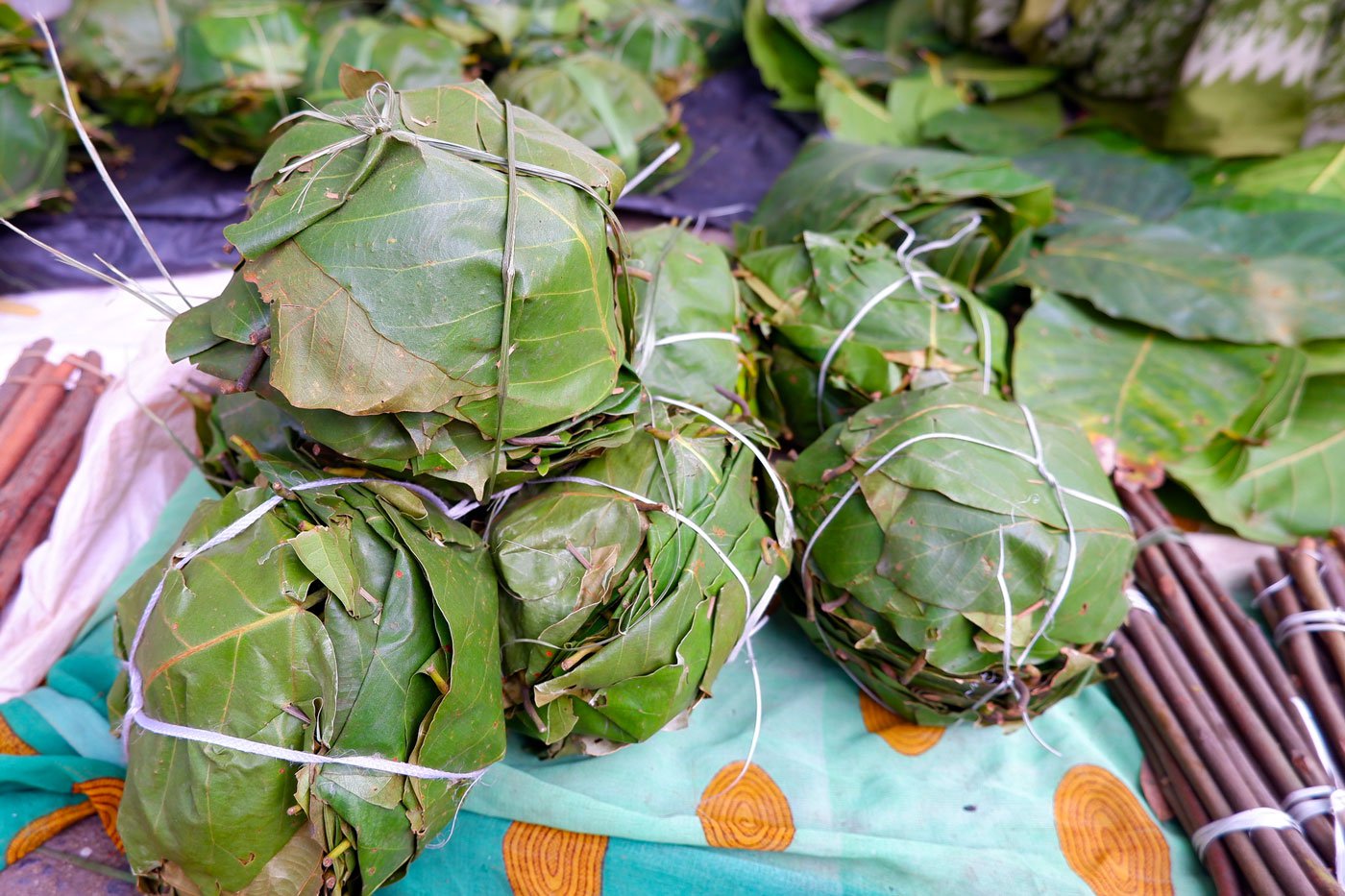

Left: Four to six leaves are arranged one upon the other and sewn together with strips of bamboo to make the dona . They fold the edges to create a circular shape so that when food is served, it won’t fall out. A bundle of 12 donas sells for four rupees. Right: Bundles of datwan are bought by passengers from the night train.
Geeta and Sakuni Devi will be here until all their wares are sold off. Sometimes that can take more than a day, up to eight, says Sakuni, “if other dona -sellers also show up.” On such occasions, the blue sheet becomes their make-shift bed for the night, and the blankets they have been carrying come in handy. If they have to stay for a few days, they eat sattu (channa porridge) twice a day, spending Rs. 50 each on buying it every day.
Their ‘shop’ is open 24x7 and passengers from
the night train buy
datwan
from them.
In the evening, Geeta and Sakuni move into the station. Daltonganj is a small
town and the station is a safer refuge.
*****
Three days later, Geeta has made Rs. 420, selling 30 bundles of dona and 80 bundles of datwan while Sakuni has sold 25 bundles of dona and 50 bundles of datwan and made Rs. 300. Armed with their earnings, the duo board the Palamu Express which leaves late at night and will get them to Barwadih next morning. From there, they have to change to a local train to get to Hehegara.
Sakuni is not happy with her earnings. “This is hard work and the money is not enough,” she says, while packing her sack.
But they will have to be back in a couple of days. “This is my livelihood,” Geeta says, “I will do this as long as my hands and feet are working.”
This story is supported by a fellowship from Mrinalini Mukherjee Foundation (MMF).
